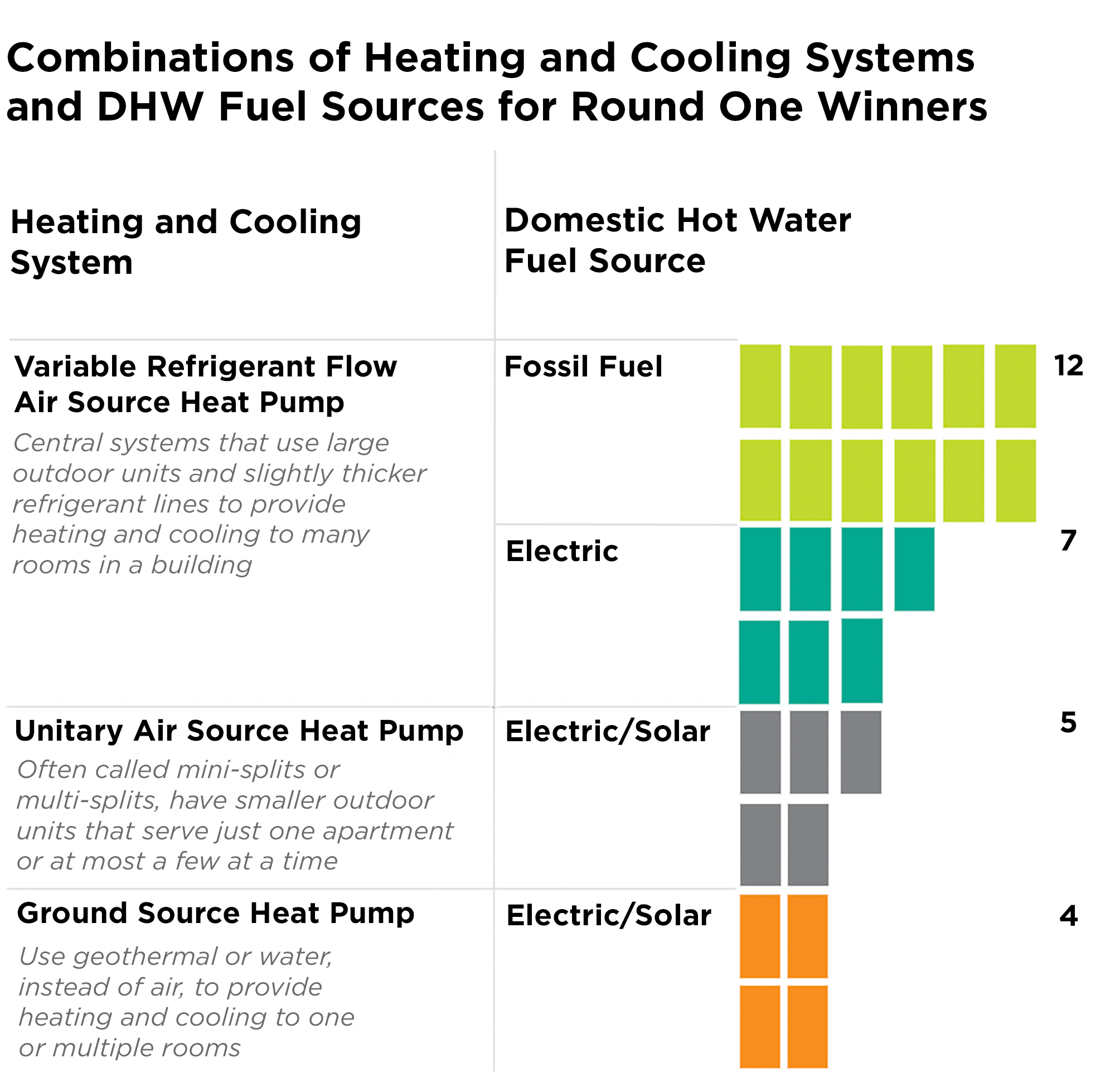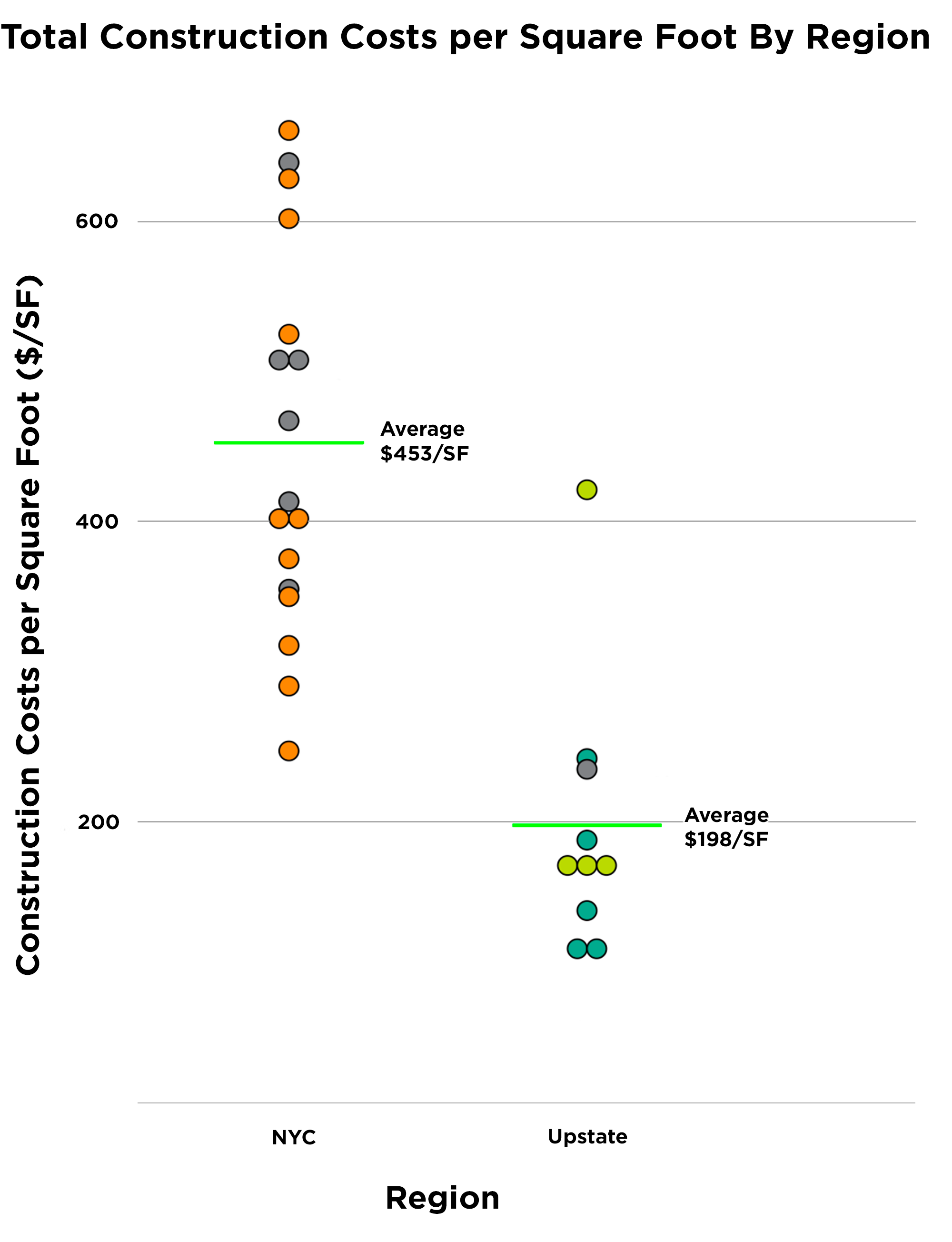A look at how NYSERDA’s Buildings of Excellence are constructed.
Original publication by Urban Green Council • July 9, 2021
New York State Energy Research and Development Authority’s (NYSERDA’s) $40 million Buildings of Excellence competition is catalyzing the design and construction of high-performance buildings in New York State. Over 40 impressive projects with replicable, low-carbon designs have already received funding in the first two rounds of the competition.
The 40 projects are spread throughout the state. In this blog, we’ll take a look at the 28 Round One winners, with 18 projects in New York City (NYC) and 10 Upstate that provide close to 2,700 new apartment units. These multifamily projects also add to the State’s affordable housing stock, as two-thirds of the units include apartments for New Yorkers with low or moderate incomes.
To better understand how the winning buildings were designed or will be built, NYSERDA published initial data on winning projects and will continue to provide updates with more detailed data as projects progress. Those data and updates will help inform the market and show that highly efficient low-carbon buildings can be built cost-competitively to traditional fossil fuel-powered dwellings and be beautiful, comfortable spaces for occupants.
Analyzing the data
Our analysis of the Round One winners found that buildings Upstate tend to have lower construction costs and take better advantage of incentives compared to larger projects in NYC. But what’s behind these cost trends? Design choices are especially limited in high-rise buildings, and winning proposals in this category all made similar decisions on how to supply heat and domestic hot water (DHW). For example, every NYC Round One winner proposed a centralized Variable Refrigerant Flow (VRF) air source heat pump (ASHP), a more expensive system that complicates and limits the availability of incentives. While that constraint contributed to higher costs in NYC, technological advances and changes to incentives will soon allow more flexibility to designers of high-rise buildings. In fact, Round Two projects demonstrate a lower average construction cost per square foot than Round One projects and increased energy performance.
The basics: Space conditioning and hot water systems
Two major aspects of any low-carbon building are the systems used for heating and cooling and DHW. The Buildings of Excellence competition asks that participants use non-fossil fuel-based heating and cooling technology, so every project chose to use electric heat pumps.[1]Three different system types were selected: VRF (Variable Refrigerant Flow) air source heat pumps are central systems that use large outdoor units and slightly thicker refrigerant lines to … Continue reading
But the Round One projects’ choices in DHW technologies are more diverse, with 16 projects using heat pump water heaters or solar thermal systems and 12 projects choosing gas-fueled systems. Notably, Round Two projects were only permitted to use the latter as backup systems as the State transitions away from fossil fuel use. Figure 1 shows the combinations of heating and cooling and DHW fuel sources for the Round One winners.
Figure 1

The most common combination of systems is space heating and cooling provided by a VRF ASHP and a DHW system fueled by gas. All 12 of these projects are buildings in NYC with over seven stories, which is not a coincidence. In early 2019, there was limited availability of and knowledge surrounding hot water heat pump systems for high-rise projects. As new products come to market, the industry is gaining confidence in estimating costs and installing heat pumps in various building types, which could lead to more all-electric high-rise projects in the near future.
Do high-performance buildings cost more?
Each project submitted a funding proposal that included initial plans for programming, energy systems and financial incentives. [2]An incremental cost is an additional investment made in a building—beyond what is typical for standard construction—in order to achieve high-performance or low-carbon goals. Figure 2 shows the estimated cost per square foot for each building before incentives, awards and tax credits. The primary driver of cost was location, as NYC projects were typically twice as expensive as Upstate ones. Within the regional groups, however, initial cost estimates varied widely without any clear trends by system.
Figure 2

One trend did emerge after incentives, awards and tax credits were applied. The competition incentives are designed to reduce incremental costs, [3]The full list of fields available for each of the 28 Round One winners can be found in NYSERDA’s published data. They include estimated design and construction costs; award values, incentives and … Continue reading and they make low carbon buildings financially competitive within their markets. Figure 3 shows that Upstate projects used incentives, awards and tax credits to reduce incremental costs by an average of 11 percent, and many estimate that their final costs will be less than traditional construction. NYC projects did not yield the same level of savings, but the incentives, awards and tax credits still reduced incremental costs by three percent on average. But since a building’s location alone doesn’t affect a project’s ability to earn incentives and credits, what is behind this gap in savings?

The answer appears to be connected to the projects’ design choices. All but one of the Upstate projects selected unitary ASHPs or ground source heat pumps, while all NYC projects use VRF ASHPs for heating. Most incentive programs require that heat pumps be certified for cold climates by the Northeast Energy Efficiency Partnerships (NEEP). Thousands of unitary ASHP models have had this certification for years, but 2021 is the first year NEEP will certify cold climate VRF ASHP models. This will open more incentive programs up to high-rise buildings in NYC that use VRF ASHP systems.
More detailed data is on the way!
Another exciting aspect of the Building of Excellence Competition is that detailed construction cost data—beyond what was included in the initial proposals—is added to the public dataset available on NYSERDA’s website as the projects progress. These costs are broken down into 10 categories that influence performance, including HVAC, DHW and envelope. This information is an invaluable resource for developers and policymakers as they plan new housing projects with the lowest emissions possible.
Detailed costs are currently available for a small number of the winning projects. However, new data is added every month, which we will be able to use to dive deeper into New York’s next generation of all-electric low-carbon buildings. Stay tuned for more Buildings of Excellence updates from NYSERDA. These innovative projects will blaze the path to New York’s zero-emission future!
References
| ↑1 | Three different system types were selected:
|
|---|---|
| ↑2 | An incremental cost is an additional investment made in a building—beyond what is typical for standard construction—in order to achieve high-performance or low-carbon goals. |
| ↑3 | The full list of fields available for each of the 28 Round One winners can be found in NYSERDA’s published data. They include estimated design and construction costs; award values, incentives and tax credits; building and market attributes; renewable power systems and estimated building energy performance. |